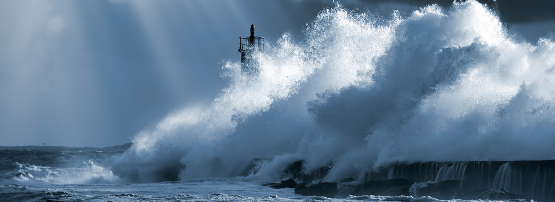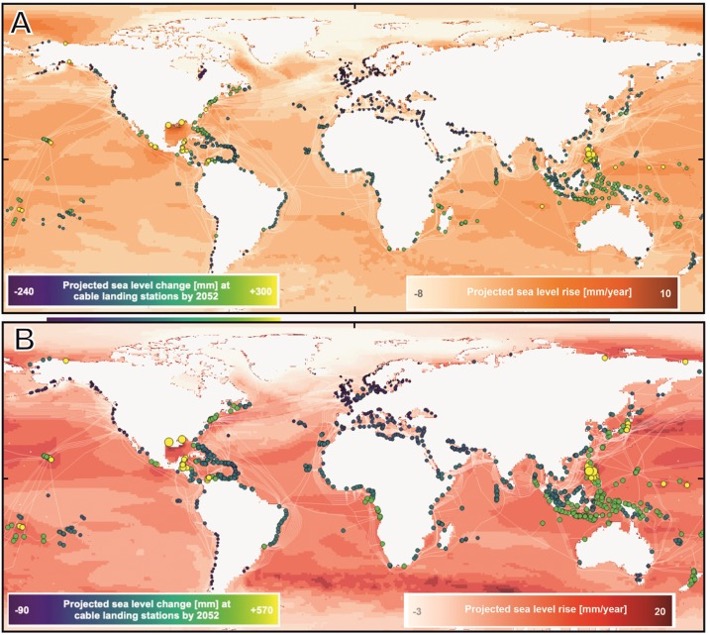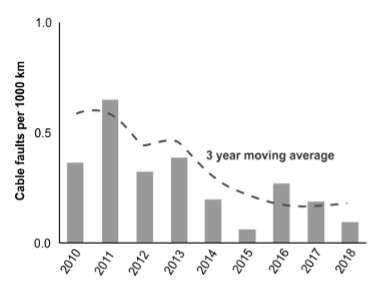
Infrastructure networks are experiencing new or aggravated threats associated with our changing climate. Flooding, storms, coastal erosion, and other natural hazards are becoming more frequent and extreme, with the most significant impacts often felt by the most vulnerable communities.
The global network of subsea cables that underpins the Internet is no exception. Climate hazards represent a growing but poorly understood threat to the >1.6M kilometres of subsea telecommunications cables crossing the oceans. These cables, typically no wider than a garden hosepipe, are the critical arteries for >99% of international digital data traffic, including the Internet, and carry trillions of dollars per day in financial transactions.
Changes in the frequency, rate, magnitude, and nature of climate hazards will depend on the extent and timescale over which we reduce global fossil fuel emissions. Research into different greenhouse gas emission scenarios has started to explore how future climate change may affect subsea cables and their shore-based landing stations.
Climate-driven outages are happening now
Sea-level rise is expected to have the most direct and immediate impact on subsea infrastructure, notably landing stations. Many are built close to coastlines, and some are not much higher than current sea levels. Low and high emission predictions (Figure 1) show that sea-level rises may range from 300 to 500mm.

The full effects of climate change are likely to be complex and affect different regions differently (Table 1).
| Process/ activity | Effects of climate change | Potential impacts for subsea cables or landing stations | Anticipated location of most significant impacts (hotspots) |
| Sea-level rise | A general pattern of sea-level rise (up to 20 mm/year) worldwide in response to melting ice cover and warming ocean. | Underwater iceberg keels scour seabed to damage cables. Reduced ice cover and increased storms expose the coast to erosion, while pile-up may affect coastal infrastructure. Scoring of the shelf and upper slope. Increased river discharge into the Arctic Ocean may raise the risk of turbidity currents. | The areas with the most significant sea-level rise are the Central and South Pacific islands, the Philippines, Indonesia, Japan, the West Caribbean, the Gulf of Mexico, and Northwest Australia. |
| Storm tides | The effect of sea-level rise means storm tide heights will be more significant in the future. Climate change and sea-level rise are likely to increase the frequency and magnitude of extreme sea-level events. | Direct impacts of storms on built infrastructure, including scour and abrasion of cables, undermining of landing stations, and beach utility hole covers. Storm surges may reach up to 9m above normal. | NW Europe, high latitude N and S America, E USA, E Africa, Bangladesh, Taiwan, Gulf of Mexico, NW Australia. |
| Tropical and extra-tropical cyclones | A global increase in average cyclone intensity and surface speeds, but the pattern is geographically variable. A general poleward shift of cyclone tracks. Coastal flooding via rainfall and storm surge. | Enhanced scour and abrasion. It also causes slopes to fail to form turbidity currents that can damage cables. Increased storminess and wave height reduce working windows for offshore surveys, installation, and repairs, reducing project delivery times and costs. | Complex global pattern. Increased extra-tropical storminess is anticipated in NE Atlantic and N Pacific. Increased tropical cyclone activity is expected in the NW and S Pacific, central Atlantic, and Indian Oceans. |
| Coastal erosion and seafloor sediment transport regime | Global trend of shoreline retreat due to ambient shoreline dynamics and sea-level rise. A general increase in near-bed currents and sediment mobility due to global changes in storm frequency, duration, wind speed, and wave height. | Expose, suspend, and abrade previously buried cables, undermining shore-based infrastructure, including shore-end, beach utility hole covers, and front haul routes. | Geographically widespread, but hotspots include central and eastern N America, Central America, SE South America, central Europe, E and W Africa, S Asia, N Australia, Pacific, and the Caribbean, with median values of >100 m coastal retreat by 2100. |
| Ocean currents | The intensity, location, direction, and timing of ocean currents may shift due to sea-level rise and changes in ocean temperature, salinity, and wind-forced circulation. | Impact on surveying, cable laying, and maintenance. Enhanced sediment mobility or scour around cables causes abrasion and suspension-based fatigue. | Acceleration of ocean circulation is most prominent in tropical oceans, particularly the tropical Pacific Ocean. Increase and modification of currents in the Southern Ocean. |
| Offshore weather | Storminess is changing and becoming more intense in some regions. Under high emissions scenarios, wave height and period are projected to change by 5-15% and change direction by 5-15 degrees. | Impact on surveying, cable laying, and maintenance. Decrease in previous optimal weather windows. | The largest increases in significant wave heights in the Southern Ocean and tropical E Pacific Ocean are due to increasing Southern Ocean swells that reach the tropics and the poleward shift of the tropical cyclone belt. |
| River flooding | Warming climate generally increases the risk of floods, wherein 1:100-year events may recur on much shorter timescales. | Flooding of land-based facilities. Triggering of slope failures and offshore sediment flows that can break multiple cables (most likely where rivers flow into submarine canyons). | Flood frequency is predicted to increase significantly in many regions, particularly in SE Asia, India, E &W Africa, and much of S America (excluding the extreme south), including the UK, Ireland, France, and SW USA. |
| Submarine landslides | Submarine landslides may become more likely in regions where sediment supplies increase and triggering factors are heightened. | Cyclic shelf and slope sediment loading trigger slope failures and offshore sediment flows that can break multiple cables. | Offshore from rivers where sediment supply is increased (for example, E Africa, Congo River, SE Asia) or where storm triggering is likely (for example, Caribbean, SE Asia, S Pacific). |
| Arctic sea ice and icebergs | Pressure ridges and coastal ice pile up. Coastal erosion. Calved icebergs. Enhanced river discharge. | Underwater iceberg keels scour seabed to damage cables. Reduced ice cover and increased storms expose the coast to erosion, while pile-up may affect coastal infrastructure. Scoring of shelf and upper slope. Increased river discharge into the Arctic Ocean may raise the risk of turbidity currents. | From 1979 to 2018, sea ice has likely declined for all months, and this trend is projected to continue. The record for 1900 to 2008 shows a highly variable discharge of east Greenland icebergs, with the highest rates in the 1990s. |
| Relocate fishing grounds due to changing ocean | Global warming, ocean acidification, and overfishing push stocks into newer habitats that are often cooler due to higher latitude and increased depth. | Fish stock relocation may create new conflicts between seabed users and damage to unarmoured & unburied cables by fishing gear. | Underwater iceberg keels scour seabed to damage cables. Reduced ice cover and increased storms expose the coast to erosion, while pile-up may affect coastal infrastructure. Scoring of the shelf and upper slope. Increased river discharge into the Arctic Ocean may raise the risk of turbidity currents. |
| New shipping routes due to changing conditions | Warming oceans and melting ice will open up previously ice-covered ocean routes. | New shipping routes intersect existing cable corridors, increasing the risk of damage to seafloor cables by anchoring. Other activities (for example, resource extraction may need to be considered). | Previously ice-covered parts of the Arctic. |
Table 1 — Climate change risk register outlining the anticipated effects of processes modified by future climate change, the potential impacts of subsea cables and landing stations, and identifying locations that are likely to experience the greatest impacts. Reproduced from source, 2022.
We are already seeing the impact of some of these climate effects. For example:
- Sea level rise is already being felt acutely by small low-lying islands in the South Pacific, increasing the likelihood of future flooding of landing stations by storm surges.
- The frequency and magnitude of river flooding are accelerating in many places, increasing the likelihood of offshore sediment flows that damaged multiple subsea cables offshore West Africa over the past four years.
- The Atlantic Ocean is experiencing more significant storms, contributing to cutting Internet connections.
- The intensity of tropical storms appears to be increasing in the Caribbean, with widespread damage to cables and landing stations.
- Calving of icebergs has damaged cables in Alaska, leading to significant lost connection time before repair.
Lessons and building resilience for the future
The emergence of these climate hazards is not news to the subsea cable industry. The International Cable Protection Committee published a position statement on climate change in 2020 and stated at a consultative meeting of the United Nations:
“It is critical that sea-level rise and climate change be considered in future route and landing station planning, as well as assessing the risk posed to existing systems.”
Given a subsea cable system’s typical 25-year design life, forward planning is essential, particularly to understand how hazards may change and implement mitigation measures to safeguard against their adverse impacts.
Such measures include:
- Increasing the armouring and cable protection at shore ends where erosion is worsening.
- Avoiding low-lying areas for landing points and cable landing stations.
- Gathering local knowledge from site visits regarding environmental conditions and impacts of historical events.
- Incorporating ocean modelling and scientific datasets into early-stage route planning assessments.
According to a recent presentation by the International Cable Protection Committee, despite changing ocean conditions, the number of cable repairs has remained at around an average of 200 per year over the past ten years, despite the total length of in-service cables growing by more than 600,000km.
The number of faults per unit length is decreasing (Figure 2), continuing a longer-term trend of increasingly resilient subsea cable systems. This is a testament to the subsea cable industry’s learning from past instances of cable damage, improving cable routing and design, and commissioning and listening to the science that provides a key evidence base to inform decision-making.

Climate change is also providing unexpected opportunities, such as the opening up of new routes that were previously covered by sea ice.
However, many uncertainties remain. Future advancements in ocean observation and modelling are required to enhance our understanding of how, where, and when climate change will affect the ocean. This can help the industry assess and adapt to emerging and changing hazards and continue strengthening the resilience of the global network.
Read our recent study to learn more about climate hazards for subsea cables.
Contributors: Isobel Yeo and Lucy Bricheno.
Michael Clare is an ocean science researcher at the National Oceanography Centre in the UK. His team’s research, which collaborates closely with the International Cable Protection Committee, focuses on natural hazards and their threats to seafloor infrastructure and coastal communities.
This post was originally published on the Internet Society’s Pulse Blog.
The views expressed by the authors of this blog are their own and do not necessarily reflect the views of APNIC. Please note a Code of Conduct applies to this blog.
